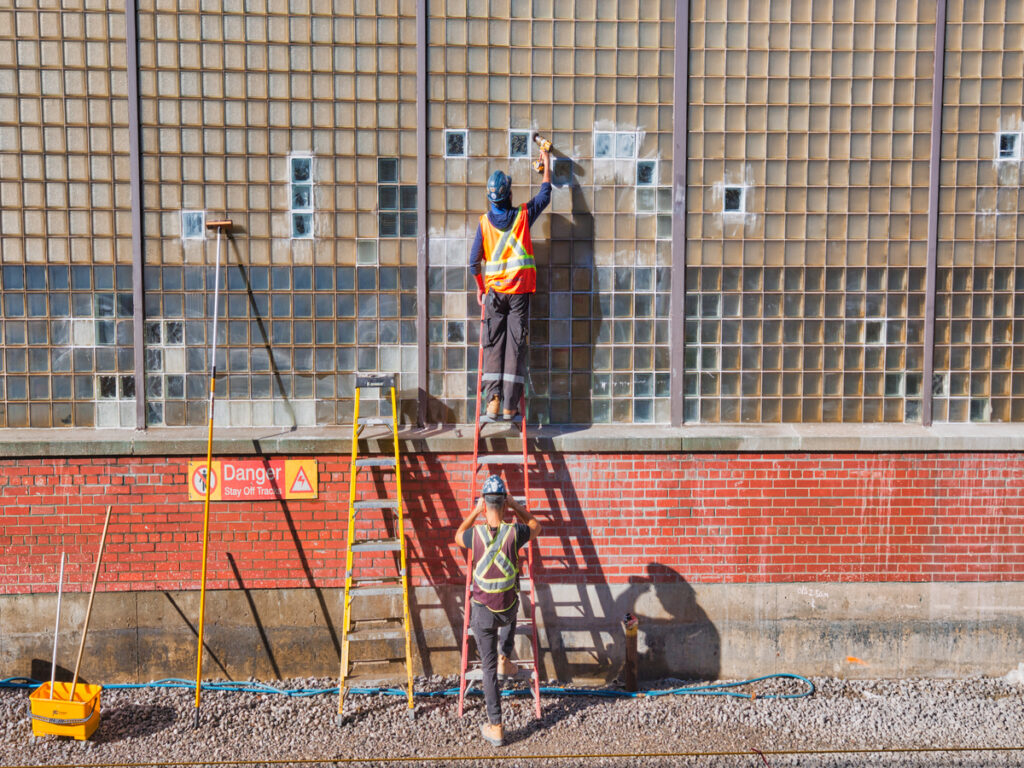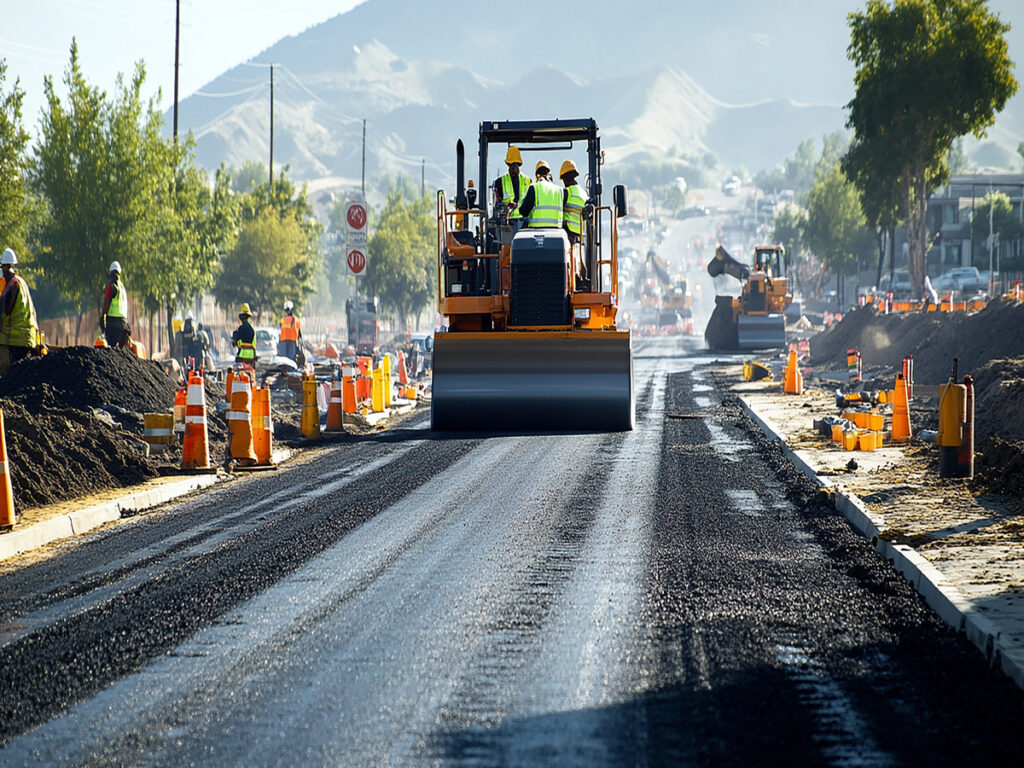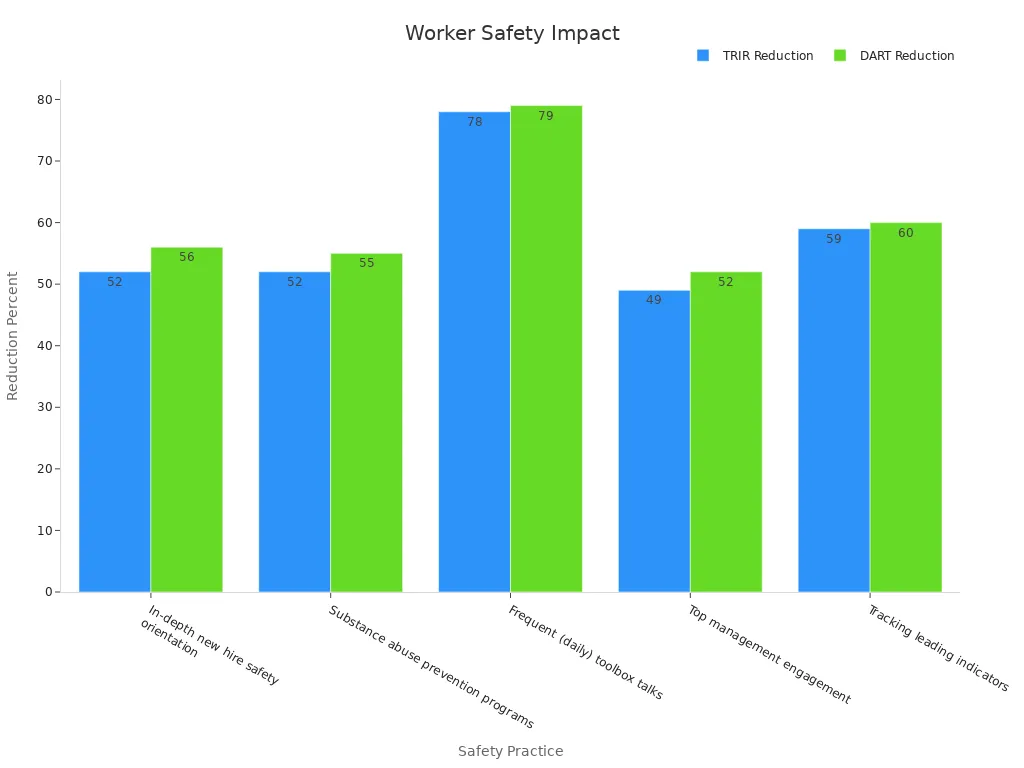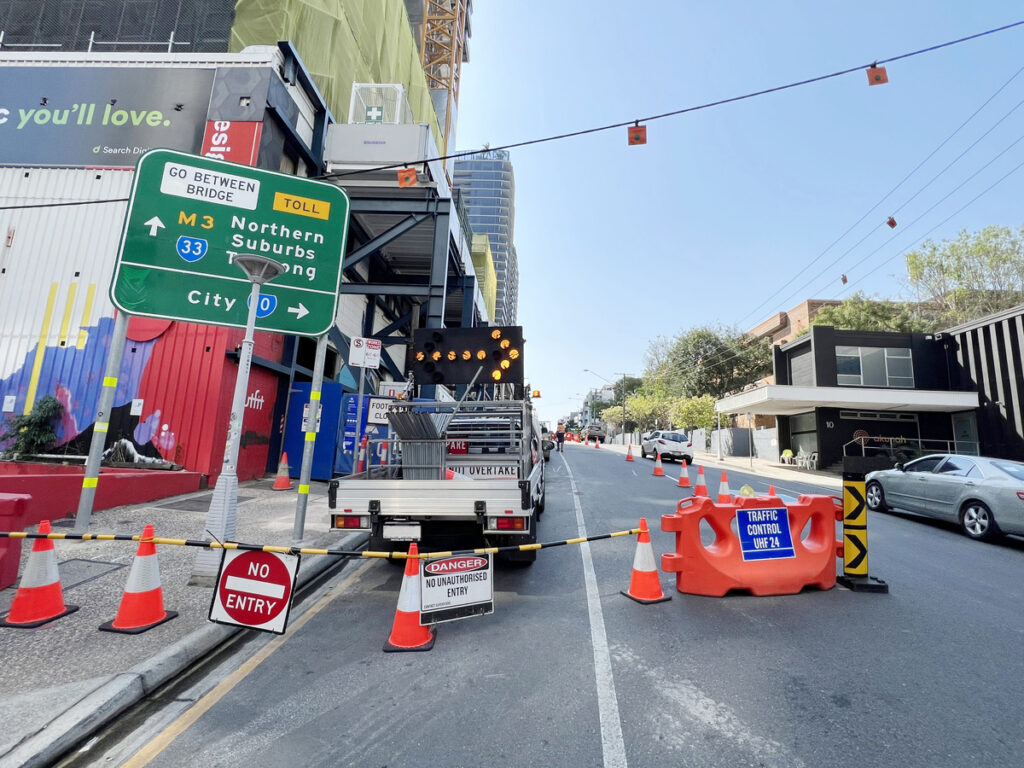
Ensuring OSHA compliance stands as a top priority when installing construction bollards in any active work zone. Non-compliance can lead to accidents, multas, or project delays. Properly installed construction bollards protect workers, pedestres, and equipment from vehicle intrusion. Safety checklists and clear procedures help teams avoid mistakes. Every job site benefits when crews follow established safety standards.
OPTRAFFIC offers expert guidance and durable Bollards de tráfego para venda that help ensure your site complies with OSHA regulations, protecting both workers and property. With their reliable bollard solutions, your site can remain secure and compliant, minimizing risks while optimizing safety.
Takeaways -chave
- Proper installation of construction bollards protects workers and equipment by preventing vehicle intrusions and reducing accidents.
- Following OSHA safety standards and guidelines, including correct bollard spacing and placement, helps avoid fines and keeps job sites safe.
- Choosing the right bollard type and material depends on site needs, impact risks, and maintenance costs to ensure long-lasting protection.
- Regular inspections and maintenance keep bollards effective and compliant, preventing damage and ensuring worker safety.
- Using checklists and expert advice improves installation quality and helps teams meet OSHA requirements confidently.
OSHA and Construction Safety
O que é OSHA?
O Administração de Segurança e Saúde Ocupacional (OSHA) sets and enforces safety standards for workplaces across the United States. OSHA began in 1970 to address high rates of workplace injuries and fatalities. Desde então, OSHA has played a major role in improving safety for construction workers. The following table shows how OSHA’s efforts have reduced injuries and deaths over time:
| Metric Description | Numerical Data | Ano(é) |
|---|---|---|
| Average worker fatalities per day | 38 | 1970 |
| Average worker fatalities per day | 15 | 2022 |
| Injury and illness rate per 100 trabalhadores | 10.9 | 1972 |
| Injury and illness rate per 100 trabalhadores | 2.7 | 2022 |
| Fatality rate per 100,000 employees | 3.7 | 2022 |
| Percentage of OSHA safety inspections at construction sites | Aproximadamente 50% | 2022 |
| Number of fall protection violations | 5,465 | 2021 |
| Total fines for fall protection violations | $28.8 milhão | 2021 |
OSHA’s Role in Construction Zones
OSHA focuses on construction zones because these sites have many hazards. Inspectors visit nearly half of all construction sites each year. OSHA enforces rules that protect workers from falls, equipment accidents, and vehicle intrusions. The agency uses fines and penalties to make sure companies follow safety standards. Por exemplo, a single contractor once faced a penalty of $8.35 million for violations. The most common citations involve fall protection, escadas, and scaffolding. These efforts help reduce the number of injuries and deaths on construction sites.
| Métrica | Estatística | Explicação |
|---|---|---|
| Maximum OSHA penalty for a single contractor | $8.35 milhão (2010) | Demonstrates OSHA’s enforcement power through financial penalties |
| OSHA penalty per serious violation | Até $16,550 | Shows financial consequences for safety violations |
| OSHA penalty per day for failure to abate | $16,550 | Highlights ongoing penalties for non-compliance |
| OSHA penalty per willful/repeated violation | Até $165,514 | Emphasizes severity of repeated violations |
| Most cited OSHA construction regulation (2023) | Lack of fall protection: 6,616 citações | Indicates focus area of OSHA enforcement in construction safety |
| Construction fatalities annually | Sobre 1,000 desde 2016 | Contextualizes the human cost OSHA aims to reduce |
| Percentage of fatalities from “Focus Four” hazards (2011-2020) | 65% of fatal injuries | Shows OSHA’s focus on major hazard categories in construction |
Why Bollard Installation Matters
Construction bollards play a key role in site safety. They stop vehicles from entering restricted areas and protect workers, pedestres, e equipamento. Cada dia, bollards prevent up to 100 vehicle crashes into buildings, which helps avoid thousands of injuries and deaths every year. Bollards create strong barriers that reduce accidents and improve traffic flow. Real-world projects, such as the Public Square Bollard Project in Cleveland, show how replacing temporary barriers with removable bollards increases safety for everyone on site. Proper placement at access gates, passarelas, and site perimeters controls traffic and keeps unauthorized vehicles out. Using the right installation method and material ensures that bollards meet strict safety standards and provide lasting protection.
Key OSHA Regulations

Traffic Control Standards
OSHA requires clear traffic control in construction zones to protect workers and the public. These standards include using signs, barreiras, and bollards to guide vehicles and prevent accidents. O Manual sobre Dispositivos Uniformes de Controle de Tráfego (MUTCD) works alongside OSHA rules to set guidelines for signs and barriers. Construction sites must use visible and sturdy bollards to block unauthorized vehicles. Proper traffic control reduces confusion and keeps everyone safe.
Worker Safety Requirements
Worker safety requirements form the backbone of OSHA’s mission. Employers must train workers, provide safety equipment, and share information about hazards. Research shows that strong safety practices lead to fewer incidents. Por exemplo, frequent toolbox talks and management engagement can lower incident rates by over 50%. The table below highlights how specific safety practices reduce workplace injuries:
| Safety Practice | Reduction in TRIR | Reduction in DART |
|---|---|---|
| In-depth new hire safety orientation | 52% | 56% |
| Substance abuse prevention programs | 52% | 55% |
| Freqüente (diário) toolbox talks | 78% | 79% |
| Top management engagement | 49% | 52% |
| Tracking leading indicators | 59% | 60% |

General Duty Clause
The General Duty Clause requires employers to keep workplaces free from recognized hazards. This rule covers dangers not addressed by specific OSHA standards. By following this clause, companies improve safety culture and reduce accidents. Data shows that OSHA uses the General Duty Clause for about 1.5% of citations, making it a key tool for unregulated hazards. Employers who follow this rule see fewer injuries, custos mais baixos, and better morale.
Observação: O General Duty Clause gives OSHA the flexibility to address new or unique hazards, ensuring that all risks receive attention.
Other Relevant Standards
Other OSHA standards also help keep construction sites safe. Studies show that OSHA inspections and enforcement lower injury rates and costs. Por exemplo, after inspections with penalties, injury rates drop by up to 24%. These standards cover topics like steel erection, electrical safety, e equipamentos de proteção individual. By following all relevant rules, construction teams create safer environments and prevent costly accidents.
Construction Bollards: Types and Uses

Fixed and Removable Bollards
Construction sites use both fixed and removable bollards to control access and protect workers. Fixed bollards stay in place and provide strong, Barreiras permanentes. Removable bollards offer flexibility for changing site needs. The table below compares their performance in construction zones:
| Métrica de desempenho | Boldes fixos | Boldes removíveis |
|---|---|---|
| Resistência ao impacto | Alto; deep concrete encasement | Moderado; not deeply anchored |
| Método de instalação | Permanente, requires groundwork | Rápido, uses ground sleeves or base plates |
| Flexibilidade | No adaptability after installation | Can be moved or stored as needed |
| Manutenção | Minimal after installation | Mais frequente, especially for moving parts |
| Custo | Higher upfront, lower long-term | Lower upfront, higher ongoing |
| Suitable Use Cases | Alta segurança, proteção permanente | Temporary zones, shifting access needs |
Opções de material
Material choice affects durability, manutenção, e custo. Steel and concrete offer strong impact resistance but may need more upkeep. Polymer and stainless steel provide high durability and low maintenance. The table below outlines key differences:
| Material | Custo inicial | Manutenção | Durability and Replacement | Notas |
|---|---|---|---|---|
| Aço | Mais baixo | Needs repainting | Compromised after impacts | Prone to rust |
| Concreto | Moderado | Needs repainting | Withstands force, costly to replace | Footings may need repair |
| Polímero | Mais alto | Mínimo | Withstands multiple impacts | UV estável, sem ferrugem, fácil de limpar |
| Aço inoxidável | Mais alto | Mínimo | Altamente durável, resistente à ferrugem | Ideal for harsh weather and high traffic |
Crash Ratings
Crash ratings help teams select the right construction bollards for safety. Standards like DOS K Ratings, ASTM F2656-07, and BSI PAS 68:2010 measure how well bollards stop vehicles. Por exemplo, a K4 rating means a bollard can stop a 15,000-pound truck at 30 MPH com menos de 1 meter of penetration. ASTM F2656-07 uses ratings like M30 P1, which means a medium truck at 30 MPH com menos de 1 meter of penetration. These ratings ensure bollards meet OSHA and MUTCD safety standards.
Quando usar cada tipo
Fixed bollards work best in high-security or permanent construction zones. Removable bollards fit areas where access changes often, such as temporary work zones or event spaces. Polymer bollards suit high-traffic areas needing visibility and low maintenance. Stainless steel bollards resist rust and last in harsh weather. Teams should always check OSHA, MUTCD, and ADA guidelines before choosing and placing construction bollards.
Dica: Always match the bollard type and material to the site’s security needs and expected vehicle impact speeds.
Colocação e espaçamento
Preventing Vehicle Intrusion
Strategic placement of construction bollards creates a strong barrier between vehicles and work zones. Cada ano, vehicle incursions into storefronts injure thousands and cause many deaths. Research from the Storefront Safety Council shows that 90% of these incidents result from driver error or mechanical failure. Installing bollards in the right locations can prevent these accidents. After cities like New York and London added crash-rated bollards, they saw fewer vehicle intrusions in crowded areas. These bollards absorb impact and stop unauthorized vehicles from entering restricted zones. Site managers should always assess traffic patterns, terreno, and security needs before deciding where to install barriers.
Safe Zones for Workers
Safe zones protect workers from moving vehicles and equipment. Teams use construction bollards to mark the boundaries of these zones. Workers stay safer when barriers separate them from active traffic lanes. Placing bollards at site entrances, passarelas, and around equipment storage areas helps create clear, protected spaces. This setup reduces the risk of accidental vehicle entry and keeps workers focused on their tasks.
Dica: Always use high-visibility bollards or add reflective tape to increase awareness, especialmente em condições de pouca luz.
Spacing and Alignment
Proper spacing and alignment ensure that bollards block vehicles without creating hazards for pedestrians. OSHA and MUTCD recommend placing bollards close enough to prevent cars from passing through but far enough apart for emergency access. A common guideline is 3 para 5 feet between bollards. Aligning bollards in a straight line improves both appearance and effectiveness. Teams should check local codes for any special spacing requirements.
Traffic Flow and Segregation
Well-placed bollards help manage traffic flow and keep vehicles and pedestrians separate. Studies show that using fluorescent orange sheeting on warning signs and placing changeable message signs (Cms) at specific distances improves lane changes and reduces traffic conflicts. The table below highlights key measurements that improve traffic flow and segregation:
| Medição | Effect on Traffic Flow and Segregation | Statistical Validation |
|---|---|---|
| Fluorescent orange sheeting on signs | Fewer traffic conflicts, more trucks move out of left lane earlier | Significant reduction in conflicts and lane occupancy |
| CMS at 3,960 ft advance, arrow panel at 2,000 ft | Smoother lane changes, fewer late exits | Supported by large-scale data |
Construction bollards, when combined with these strategies, create safer and more organized construction zones.
Altura, Material, e durabilidade
Height and Size Requirements
Bollard height plays a critical role in both visibility and effectiveness. Most construction bollards stand between 36 e 48 polegadas de altura. This range ensures drivers and pedestrians can see the barriers clearly. Industry standards recommend this height to balance safety and accessibility. Spacing between bollards should not exceed 48 polegadas. This prevents vehicles from passing through while allowing people to move freely. These guidelines reflect best practices found in crash test data and safety codes.
- Typical height: 36–48 inches
- Espaçamento máximo: 48 polegadas
- Ensures visibility and accessibility
Material Strength
Construction zones demand bollards with high strength. Most sites use cast iron or steel pipes anchored in concrete. These materials provide strong resistance to vehicle impacts. Accredited laboratories, certified under ISO/IEC 17025, test bollards for tensile strength, compressive strength, and crush resistance. These tests confirm that the bollards can withstand the forces expected in real-world crashes. Standards such as ASTM F2656, NÃO 68, e iwa 14 set benchmarks for crash resistance. Por exemplo, an M50 rating means a bollard can stop a 15,000-pound vehicle traveling at 50 km/h.
Durability in High-Traffic Areas
Durability becomes essential in busy construction zones. Steel and concrete bollards offer long-term performance and withstand repeated impacts. Plastic bollards, while less durable, provide flexibility and are easy to install. They work well in temporary or low-impact areas. Stainless steel resists rust and weather, tornando -o adequado para uso ao ar livre. Regular inspections help maintain durability and ensure continued protection.
Selecting the Right Material
Choosing the right material involves balancing cost, durabilidade, and maintenance. Plastic bollards cost less and require minimal upkeep, tornando-os ideais para projetos de curto prazo. Steel and concrete offer greater strength for high-risk areas. Mais de cinco anos, using plastic covers instead of painting steel posts can save up to $464,000 para 3,200 Postagens. The initial cost per post is similar, but plastic covers eliminate ongoing maintenance expenses. This cost-benefit analysis helps project managers select materials that meet both safety and budget needs.
| Ano | Painting Cost (3,200 Postagens) | Plastic Bollard Covers Cost | Poupança Anual (Painting vs. Covers) |
|---|---|---|---|
| First Year | $112,000 | $96,000 | $16,000 |
| Second Year | $112,000 | $0 | $112,000 |
| Third Year | $112,000 | $0 | $112,000 |
| Fourth Year | $112,000 | $0 | $112,000 |
| Fifth Year | $112,000 | $0 | $112,000 |
Dica: Project managers should consider both the initial investment and long-term maintenance when selecting bollard materials for construction zones.
Métodos de instalação
In-Ground vs. Surface-Mount
Escolhendo o direito installation method for construction bollards depends on site needs and safety requirements. In-ground (embedded) bollards offer the highest level of stability and impact resistance. Crews install these bollards into a concrete foundation below ground. Surface-mounted bollards attach to existing concrete or asphalt using heavy-duty bolts. This method works well when digging is not possible or when a quick installation is needed.
| Installation Type | Stability Level | Método de instalação | Aplicações adequadas |
|---|---|---|---|
| Embedded (In-ground) | Maximum stability and impact resistance | Installed into a below-ground concrete foundation | High-security and heavy-traffic areas |
| Surface-mounted | Less stability than embedded | Anchored to concrete or asphalt with heavy-duty bolts | When excavation is not possible or prohibited; quicker installation |
Project managers should select the installation type based on the level of protection required and the conditions at the site.
Etapas de instalação
Proper installation ensures that construction bollards provide reliable protection. Teams should follow these steps for OSHA and MUTCD compliance:
- Plan the Layout
Mark the exact locations for each bollard. Use site drawings and traffic flow maps to guide placement. - Prepare the Site
For in-ground bollards, dig holes to the required depth and width. For surface-mount bollards, clean and level the surface. - Check for Utilities
Always check for underground utilities before digging. This step prevents accidents and costly repairs. - Install the Bollard
- For in-ground: Place the bollard in the hole and fill with concrete. Ensure the bollard stands straight and at the correct height.
- For surface-mount: Position the bollard and secure it with heavy-duty anchor bolts.
- Allow for Curing
Let the concrete cure fully before exposing the bollard to impact or heavy use. - Inspect and Document
Inspect each bollard for alignment and stability. Record installation details for compliance and future maintenance.
Dica: Always follow manufacturer instructions and local codes for installation depth, bolt size, and curing time.
Securing Bollards
Securing construction bollards properly is essential for safety and emergency access. Several methods exist, each with unique benefits:
- Padlocked collapsible bollards take about 30–35 seconds to collapse three units using a key box and padlock. Rust or debris can sometimes cause lock issues.
- Hydrant wrench collapsible bollards unlock and collapse in about 20 seconds for three units. First responders often carry the required wrench.
- Apparatus bumper force bollards collapse in roughly 5 seconds when struck by an emergency vehicle bumper. These bollards are designed for quick repair after use.
These options help balance security with emergency access. FEMA studies show that bollards remain a cost-effective and versatile safety measure for many sites.
Observação: Always test locking mechanisms and moving parts during routine inspections to ensure reliable operation.
Avaliação do local
A thorough site assessment forms the foundation of a safe and effective bollard installation. Urban development studies show that cities like London reduced vehicular attacks in pedestrian areas by 30% after installing retractable bollards with careful planning. Teams should evaluate traffic patterns, movimento de pedestres, ground conditions, and the presence of underground utilities. Checking for utilities prevents hazards and avoids expensive repairs. The right assessment helps determine the best bollard type, colocação, and installation method for each location.
Chamar: Comprehensive site assessments improve safety, durabilidade, and the long-term effectiveness of construction bollards.
Manutenção e inspeção
Inspeções regulares
Regular inspections help keep construction bollards effective and safe. Teams should check for visible damage, loose fittings, and signs of rust or corrosion. While some believe that more frequent inspections reduce accidents, research by Miscetti et al. (2008) found no clear evidence that increasing inspection intervals leads to fewer injuries on construction sites. Em vez de, the focus should remain on thoroughness and proper documentation. Inspectors should use a checklist to record findings and note any repairs needed. Keeping detailed records supports OSHA compliance and helps track the condition of each bollard over time.
Ongoing Maintenance
Ongoing maintenance ensures that construction bollards continue to protect workers and equipment. Teams should clean bollards regularly with warm soapy water to remove dirt and debris. This simple step prevents buildup that could affect performance. Lubricating moving parts, such as hinges on removable bollards, keeps them working smoothly. Following manufacturer guidelines for lubrication and cleaning helps avoid unnecessary wear. No inverno, applying de-icing agents and removing snow prevents operational failures.
Assessing and Replacing Bollards
Assessment involves checking each bollard for cracks, dentes, or other signs of damage. If a bollard shows severe wear or cannot be repaired, replacement becomes necessary. Teams should look for rust, loose anchors, or bent posts. When damage is found, prompt action reduces the risk of accidents. Professional maintenance services can provide expert inspections and timely repairs, which extend the lifespan of construction bollards.
Upkeep Best Practices
Best practices for upkeep include monthly inspections, regular cleaning, and timely repairs. The table below summarizes key maintenance actions for high-impact environments:
| Tarefa de manutenção | Freqüência | Propósito |
|---|---|---|
| Inspeção visual | Mensal | Detect cracks, ferrugem, ou desgaste |
| Limpeza | Mensal | Remove dirt and debris |
| Lubrificação | As recommended | Ensure smooth operation |
| Winter care | Conforme necessário | Prevent freezing and failures |
| Professional inspection | Annually | Expert assessment and repairs |
Dica: Consistent maintenance routines help construction bollards last longer and perform better in demanding conditions.
Common Violations and Solutions
Inadequate Spacing
Many construction sites make the mistake of placing bollards too far apart. Wide gaps allow vehicles to slip through, which puts workers and pedestrians at risk. OSHA and MUTCD recommend a maximum spacing of 48 inches between bollards. Teams should measure the distance between each unit before finalizing installation. Using a spacing checklist helps prevent this common error.
Dica: Always double-check spacing with a tape measure before securing each bollard.
Improper Placement
Improper placement often leads to unsafe conditions. Some crews install construction bollards in pedestrian walkways or block emergency exits. This mistake can create new hazards instead of preventing them. Site managers should review site plans and traffic flow maps before installation. Placing bollards at access points, perimeters, and around equipment zones keeps everyone safe.
Common Placement Errors Table
| Error Type | Impacto | Solução |
|---|---|---|
| Blocking walkways | Viagens, blocked access | Follow ADA guidelines |
| Near exits | Emergency egress blocked | Keep exits clear |
| Random alignment | Confusão, reduced safety | Use site layout plans |
Unsecured Bollards
Unsecured bollards fail to provide real protection. If a bollard is loose or not anchored properly, it can move during impact. Workers should always check that each unit is firmly attached to its base. Regular inspections help catch loose fittings early. Teams should follow manufacturer instructions for anchoring and test stability after installation.
Incorrect Materials
Using the wrong materials reduces the effectiveness of construction bollards. Some sites use plastic units in high-impact areas where steel or concrete is needed. This choice can lead to quick damage or failure during a crash. Project managers should select materials based on expected vehicle speeds and site risks. Reviewing crash ratings and material strength data ensures the right choice for each location.
Observação: Choosing the correct material and installation method increases safety and reduces long-term costs.
Garantindo conformidade
OSHA Guidelines Summary
OSHA provides clear rules for safety in construction zones. These guidelines cover the use of barriers, Sinais, and construction bollards. OSHA expects employers to follow the General Duty Clause, which means they must keep the workplace free from known hazards. O manual em dispositivos uniformes de controle de tráfego (MUTCD) supports OSHA by giving extra details about traffic control. Junto, these rules help teams create safer work environments.
Dica: Always review the latest OSHA and MUTCD updates before starting a new project.
Importância da conformidade
Compliance with OSHA standards protects workers, pedestres, e propriedade. When teams follow the rules, they lower the risk of accidents and injuries. OSHA compliance also helps companies avoid costly fines and project delays. Safety records improve when crews use proper barriers and follow best practices. Good compliance shows a commitment to safety and builds trust with clients and the public.
Meeting Requirements
Teams can meet OSHA requirements by following a few key steps:
- Train all workers on safety procedures and hazard awareness.
- Use construction bollards and other barriers in the right locations.
- Inspect and maintain all safety equipment regularly.
- Keep detailed records of inspections and repairs.
- Review site plans and update them as needed.
A checklist helps teams stay organized and ensures nothing gets missed.
Expert Assistance
Às vezes, projects need expert advice. Safety consultants and OSHA specialists can review site plans and suggest improvements. They help teams understand complex rules and avoid common mistakes. Many companies offer training sessions and site assessments. These services help ensure that every installation meets OSHA standards and keeps everyone safe.
Observação: Seeking expert help early in the project can prevent costly errors and improve overall safety.
OSHA compliance remains essential for safe construction bollard installation. Teams improve site safety by focusing on proper placement, secure installation, e manutenção regular. Using checklists helps crews avoid common mistakes. Complex projects benefit from expert guidance.
Staying updated with OSHA standards protects workers and the public. Ongoing training and regular reviews of safety rules keep every job site secure.
Readers should prioritize safety and make compliance a routine part of every project.
Perguntas frequentes
What is the main purpose of construction bollards on job sites?
Construction bollards protect workers and equipment from vehicles. They create clear boundaries and help control traffic. Teams use them to prevent unauthorized access and reduce the risk of accidents.
How often should teams inspect construction bollards?
Teams should inspect bollards at least once a month. They need to check for damage, ferrugem, or loose fittings. Regular inspections help maintain safety and ensure compliance with OSHA standards.
Do OSHA regulations specify the exact spacing for bollards?
OSHA does not set a specific number. Most safety experts recommend spacing bollards no more than 48 centímetros de distância. This distance blocks vehicles but allows people to pass safely.
Can teams use plastic bollards in high-traffic construction zones?
Plastic bollards work best in low-impact or temporary areas. For high-traffic or high-risk zones, teams should choose steel or concrete bollards. These materials offer better protection against vehicle impacts.
What documentation should teams keep for OSHA compliance?
Teams should keep inspection records, maintenance logs, and installation details. These documents show that the site follows OSHA rules. Good records help during audits and improve overall safety management.



















